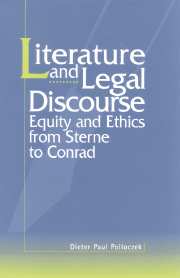Book contents
- Frontmatter
- Contents
- Preface
- Chapter 1 Introduction
- Chapter 2 Trappings of a transnational gaze: legal and sentimental confinement in Sterne's novels
- Chapter 3 Reinstitutionalizing the common law: Bentham on the security and flexibility of legal rules
- Chapter 4 Aporias of retribution and questions of responsibility: the legacy of incarceration in Dickens's Bleak House
- Chapter 5 A curse gone re-cursive: the case and cause of solidarity in Conrad's The Nigger of the “narcissus”
- Chapter 6 Conclusion
- Notes
- Index
Chapter 1 - Introduction
Published online by Cambridge University Press: 22 September 2009
- Frontmatter
- Contents
- Preface
- Chapter 1 Introduction
- Chapter 2 Trappings of a transnational gaze: legal and sentimental confinement in Sterne's novels
- Chapter 3 Reinstitutionalizing the common law: Bentham on the security and flexibility of legal rules
- Chapter 4 Aporias of retribution and questions of responsibility: the legacy of incarceration in Dickens's Bleak House
- Chapter 5 A curse gone re-cursive: the case and cause of solidarity in Conrad's The Nigger of the “narcissus”
- Chapter 6 Conclusion
- Notes
- Index
Summary
Use every man after his desert, And who should ‘scape whipping?
Shakespeare, HamletArt about ethnicity or race, about class, about gender and sexuality - in short, art that reflects, transforms, or engenders the shifting phantom of human identity - has been advanced by many as the crucial work for our time. The sixties and seventies saw the collapse of an organic historicism which considered important those works of art that embodied the contradictions of the cultures in which they were embedded. The eighties saw the decline of the “theory canon” in humanities and art departments, due to its failure to construct a rationale especially for literary curricula. Contemporary criticism in the nineties has so far been focusing on the various relations between dominant components of cultures. Among those components, literature and art are now considered to play an even more marginal role than they used to.
At the same time, critics have shifted their attention toward the phenomenon of marginalization as such. Never have so many assumed that the “othering” of minorities is an important factor in fashioning dominant or mainstream modes of culture. “Othering” in advanced industrial cultures, it is frequently argued, generally takes on more sophisticated forms than oppression and exclusion. An increased degree of inclusion, resulting from the accelerated processes of modernization, has paradoxically made it even harder for minority groups to authenticate the articulation of disadvantages by means of complaint, appeal, or resistance.
- Type
- Chapter
- Information
- Literature and Legal DiscourseEquity and Ethics from Sterne to Conrad, pp. 1 - 19Publisher: Cambridge University PressPrint publication year: 1999



